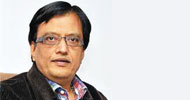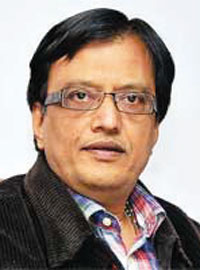

 As a Nation of more than a billion people, we need to count in the global arena. One of our great strengths is our creativity and a passion to develop innovations and technologies that can pitchfork us into a new era. Globalisation has both helped communities to grow and also be in conflict. Past twenty five years have been marked by profound technological changes as proposed by Thomas Friedman in The World is Flat. This era has seen unprecedented educational expansion and scientific discovery and helped create a whole new world.
As a Nation of more than a billion people, we need to count in the global arena. One of our great strengths is our creativity and a passion to develop innovations and technologies that can pitchfork us into a new era. Globalisation has both helped communities to grow and also be in conflict. Past twenty five years have been marked by profound technological changes as proposed by Thomas Friedman in The World is Flat. This era has seen unprecedented educational expansion and scientific discovery and helped create a whole new world.
Education is at the core of responding to challenges and opportunities. Even as we tackle the immediate numbers crisis, the economic crisis, the slowdown crisis, our long-term competitiveness and ability to deal with global challenges of self preservation and growth requires citizens prepared for the interconnected world of the 21st century.
Our goals for the Nation must therefore include ensuring that every student has access to a world – class education at affordable terms and that which produces an internationally competent workforce and informed citizenry.
Technical Education in this country is on a growth path. With more than 8000 Institutes in the Degree Sector, 2500 in the Polytechnic sector, and more than 1.5 million seats at the entry level in the degree stream, 0.5 million in the polytechnic stream, we have one of the largest Technical education systems in the world. A host of ITI’s in every State also cater to vocational education.
Today, a student who wishes to get into a technical education program can do so. A few problems like finding the finances can be facilitated through a good student loan model. The Government’s model of providing the same through setting up of a finance corporation is laudable in this context.
However the near total inclusivity has also put undue and tremendous pressure on the system to respond to the new expectations like finding suitable teaching faculty in all these Institutes, retaining them over long periods of time, providing them a facilitating mechanism to grow amongst their peers, an enabling mechanism to prosper in the societal expectations, and a suitable placement for almost 1.5 million youngsters graduating from our Institutes every year. It would also be worthwhile here to note that a student with 50 percent minimum eligibility at the qualifying examination also gets into this system along with the student at the top of the ladder. A teacher’s role here assumes tremendous significance in this context. However, unfortunately a normalisation of the process caters to common denominator and hence a fall in standards.
Our examination systems, being what they are, will also cater to common denominator that only aid in propagating more mediocrity in a system that is already mediocre. We know that mediocrity breeds only more mediocrity. A university professor once set an examination question in which he asked “what is the difference between ignorance and apathy”. The professor had to give an A+ to a student who answered: I don’t know and I don’t care.
Hence we have a system that is extremely difficult to be high on quality metrics. The industry would obviously employ the best of the lot. In the absence of an industry profile, the available job market in absolute numbers, and the available graduates, the mapping would always be incongruous.
New institutes, programs and new courses are all based on perception and whims of a few entrepreneurs, who prefer to set up institutes in the areas they choose with scant regard to the demographic needs, probably to raise their social status – however much that perception may be flawed. The affiliating universities and the State Governments do not help the cause by not preparing the perspective plans for the regions in their jurisdiction. This results in a highly skewed growth of technical education with no bearing on either industry needs or that of the country’s needs. Finding a good faculty in this scenario is a challenge since a teacher’s role in the growth of education and standards for the same cannot be overemphasised.
For almost a decade, as part of the several expert committees, I have visited various campuses of professional colleges in different parts of the country. Most of them, unfortunately, don’t have the environment that motivates the faculty to do research. Unless the quality of research and knowledge created is of a high order, a paper can’t be published in a top-ranking journal or get good citations. To write such a paper, faculty members will have to update themselves by reading about new developments in their area and interacting with the industry. This ensures they don’t teach outdated stuff. Research is a philosophy and a religion. It possibly cannot be thrust on an Institution and its faculty. Enormous funding is required, facilities created and a research ambience provided so that the teachers with research aptitude thrive. In the ultimate analysis “An educational system isn’t worth a great deal if it teaches young people how to make a living but doesn’t teach them how to make a life.” Mathematicians have sought knowledge in figures, Philosophers in systems, Logicians in subtleties, and Metaphysicians in sounds. It is not in any, nor in all of these. One who studies only men will get the body of knowledge without the soul, and he that studies only books, the soul without the body.
We need to realise the difference between an Institute that does teaching and also does research and an Institute that does research and also does teaching.
Institutes in order to be world leaders have a responsibility to create new knowledge. For this, they need to invest in faculty. This means providing them with supporting infrastructure and having a sufficient faculty development budget.
Investigations have revealed that many faculty members are experiencing dissatisfaction in their work environments and are typically becoming more dissatisfied over time. A longitudinal study by Sorcinelli (1994), for example, found 33% of new faculty in their first year reported being very stressed. This percentage rose to 49 percent in year two, and went to 71% in year five.
A new PhD faculty or someone who has worked in industry, a new faculty member at a university is faced with balancing many different issues. The new faculty member must learn the procedures at the Institution, university, teach their classes, and get their research program up and running. This could be a challenge. Orientation programs help but only so.
The strength and character of undergraduate programs in Technology is in mathematics, physics and the various fields of science which will be recognized as primary indicators of the quality of a college or university. Hence making requisite capital investments in faculty and facilities are essential steps to achieving institutional distinction.
A very important aspect here is also the exposure to international practices that a faculty gets. Internationalisation plans are critical for good faculty development. In the face of general concerns about research grants, endowments, regional and international partnerships, it is critical that institutions take time to reflect on the job faculty have at hand, that of teaching and learning. We need to realise that faculty is the strength of an institution, its face to the world that projects its academic face and eventually the incremental value addition that it does to the intelligent quotient of the universe. All available studies have shown that any investment that is made in faculty in particular and education in general has not done any harm to any country’s image but has only enhanced the same in the comity of nations.
Finally world class education should lead to skills for all so that the recipient becomes employable. Competency based skill modules that are seamlessly built into formal education as is done within the NVEQF, that provide high order skills along with a Degree or a Diploma is the new mantra that we should follow. This new paradigm would provide enhanced employability along with an increased GER.
As Anne Sullivan who herself was blind, and taught Helen Keller as a child, said and I quote, “I am beginning to suspect all elaborate and special systems of education. They seem to me to be built up on the supposition that every child is a kind of idiot who must be taught to think.” We need a paradigm that changes Education to knowledge of the world around us. It should develop in us a perspective of looking at life and help us build opinions and have points of view on life. I believe information cannot be converted to knowledge without education acting as a catalyst.
Finally, as Mahatma Gandhi said and I quote, “The real difficulty is that people have no idea of what education truly is. We assess the value of education in the same manner as we assess the value of land or of shares in the stock-exchange market. We want to provide only such education as would enable the student to earn more. We hardly give any thought to the improvement of the character of the educated. The girls, we say, do not have to earn; so why should they be educated? As long as such ideas persist there is no hope of our ever knowing the true value of education”. So friends, true value of education would be realised when we build character in our children through education and that is what we need to aim for in our Institutions.
Prof S S Mantha
Chairman, All India Council for Technical Education (AICTE)




















